ABS TOYOTA RAV4 PHEV 2021 Owners Manual
[x] Cancel search | Manufacturer: TOYOTA, Model Year: 2021, Model line: RAV4 PHEV, Model: TOYOTA RAV4 PHEV 2021Pages: 666, PDF Size: 161.28 MB
Page 78 of 666
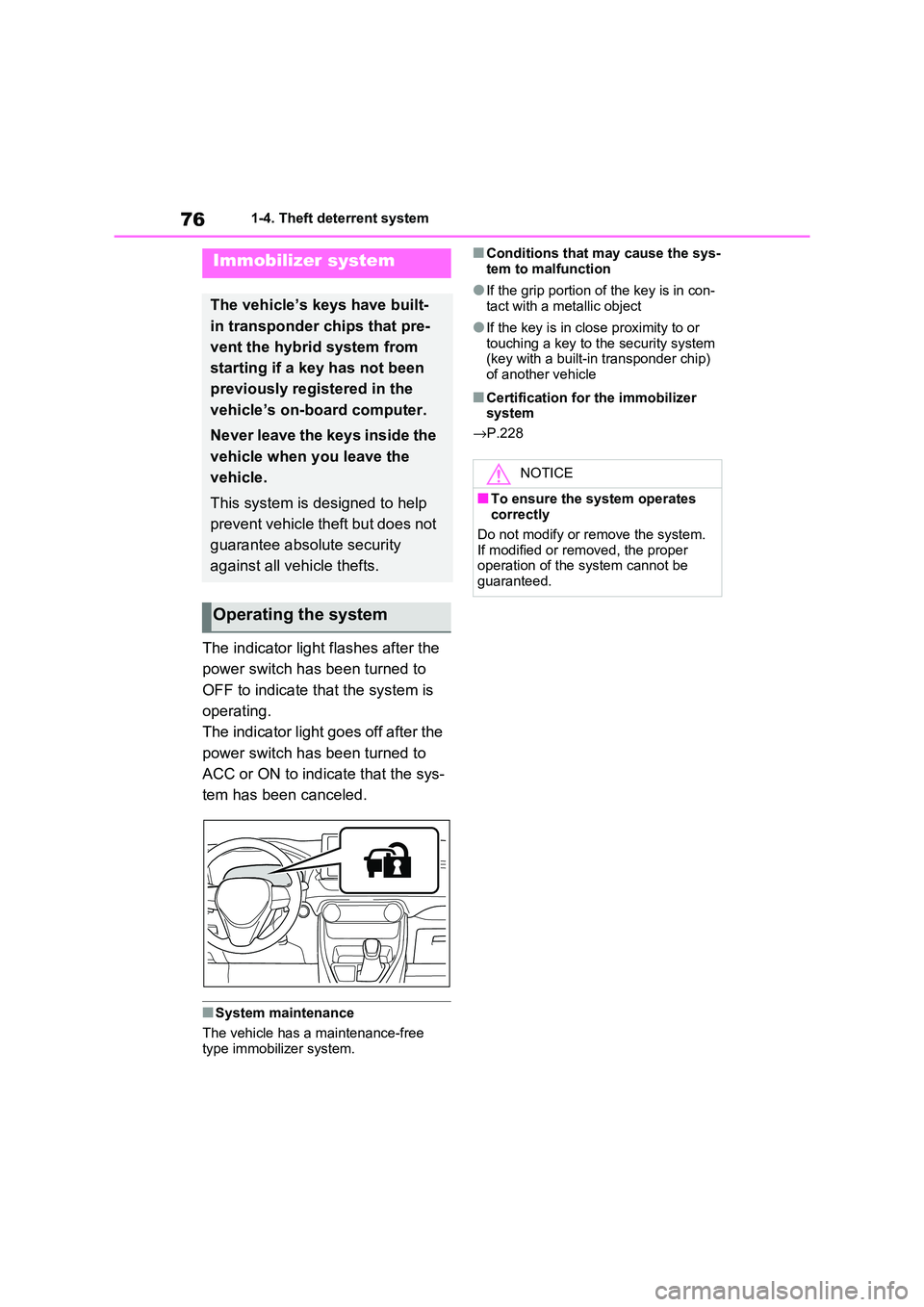
761-4. Theft deterrent system
1-4.Theft deterrent system
The indicator light flashes after the
power switch has been turned to
OFF to indicate that the system is
operating.
The indicator light goes off after the
power switch has been turned to
ACC or ON to indicate that the sys -
tem has bee n canceled.
■System maintenance
The vehicle has a maintenance-free type immobilizer system.
■Conditions that may cause the sys -
tem to malfunction
●If the grip portion of the key is in con-
tact with a metallic object
●If the key is in close proximity to or
touching a key to the security system (key with a built-in transponder chip)
of another vehicle
■Certification for the immobilizer
system
→ P.228
Immobilizer system
The vehicle’s keys have built-
in transponder chips that pre -
vent the hybrid system from
starting if a key has not been
previously registered in the
vehicle’s on-board computer.
Never leave the keys inside the
vehicle when you leave the
vehicle.
This system is designed to help
prevent vehicle theft but does not
guarantee absol ute security
against all vehicle thefts.
Operating the system
NOTICE
■To ensure the system operates
correctly
Do not modify or r emove the system. If modified or remo ved, the proper
operation of the system cannot be
guaranteed.
Page 81 of 666
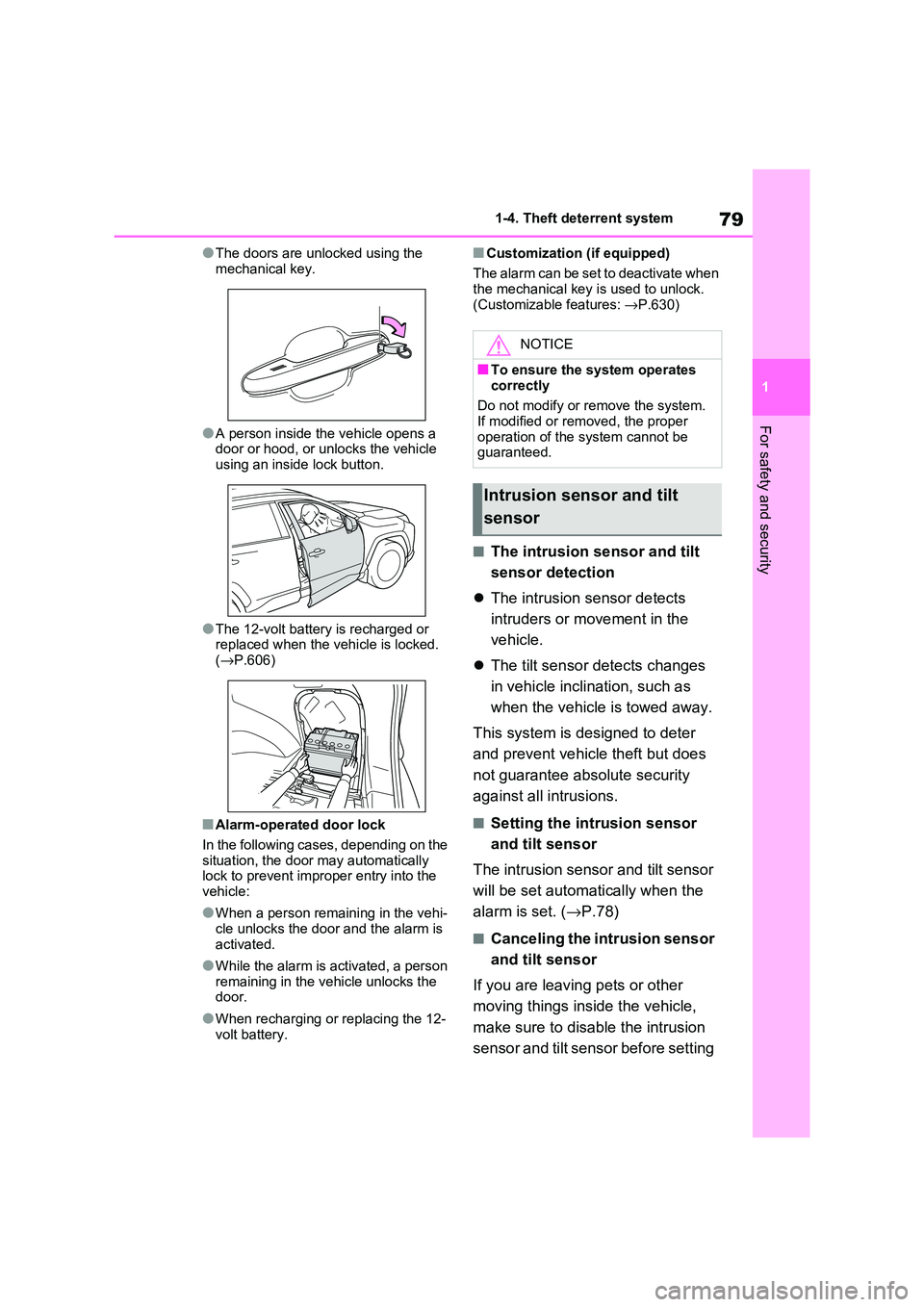
79
1
1-4. Theft dete rrent system
For safety and security
●The doors are unlocked using the
mechanical key.
●A person inside the vehicle opens a
door or hood, or unlocks the vehicle using an inside lock button.
●The 12-volt battery is recharged or replaced when the v ehicle is locked.
( →P.606)
■Alarm-operated door lock
In the following cases, depending on the
situation, the door may automatically lock to prevent impro per entry into the
vehicle:
●When a person rem aining in the vehi-
cle unlocks the door and the alarm is
activated.
●While the alarm is activated, a person
remaining in the v ehicle unlocks the door.
●When recharging or replacing the 12-
volt battery.
■Customization (if equipped)
The alarm can be set to deactivate when the mechanical key is used to unlock.
(Customizable features: →P.630)
■The intrusion sensor and tilt
sensor detection
The intrusion sensor detects
intruders or movement in the
vehicle.
The tilt sensor detects changes
in vehicle inclination, such as
when the vehicle is towed away.
This system is designed to deter
and prevent vehicle theft but does
not guarantee abs olute security
against all intrusions.
■Setting the intrusion sensor
and tilt sensor
The intrusion sensor and tilt sensor
will be set automa tically when the
alarm is set. ( →P.78)
■Canceling the intrusion sensor
and tilt sensor
If you are leaving pets or other
moving things inside the vehicle,
make sure to disable the intrusion
sensor and tilt sensor before setting
NOTICE
■To ensure the system operates correctly
Do not modify or r emove the system.
If modified or remo ved, the proper
operation of the system cannot be guaranteed.
Intrusion sensor and tilt
sensor
Page 172 of 666
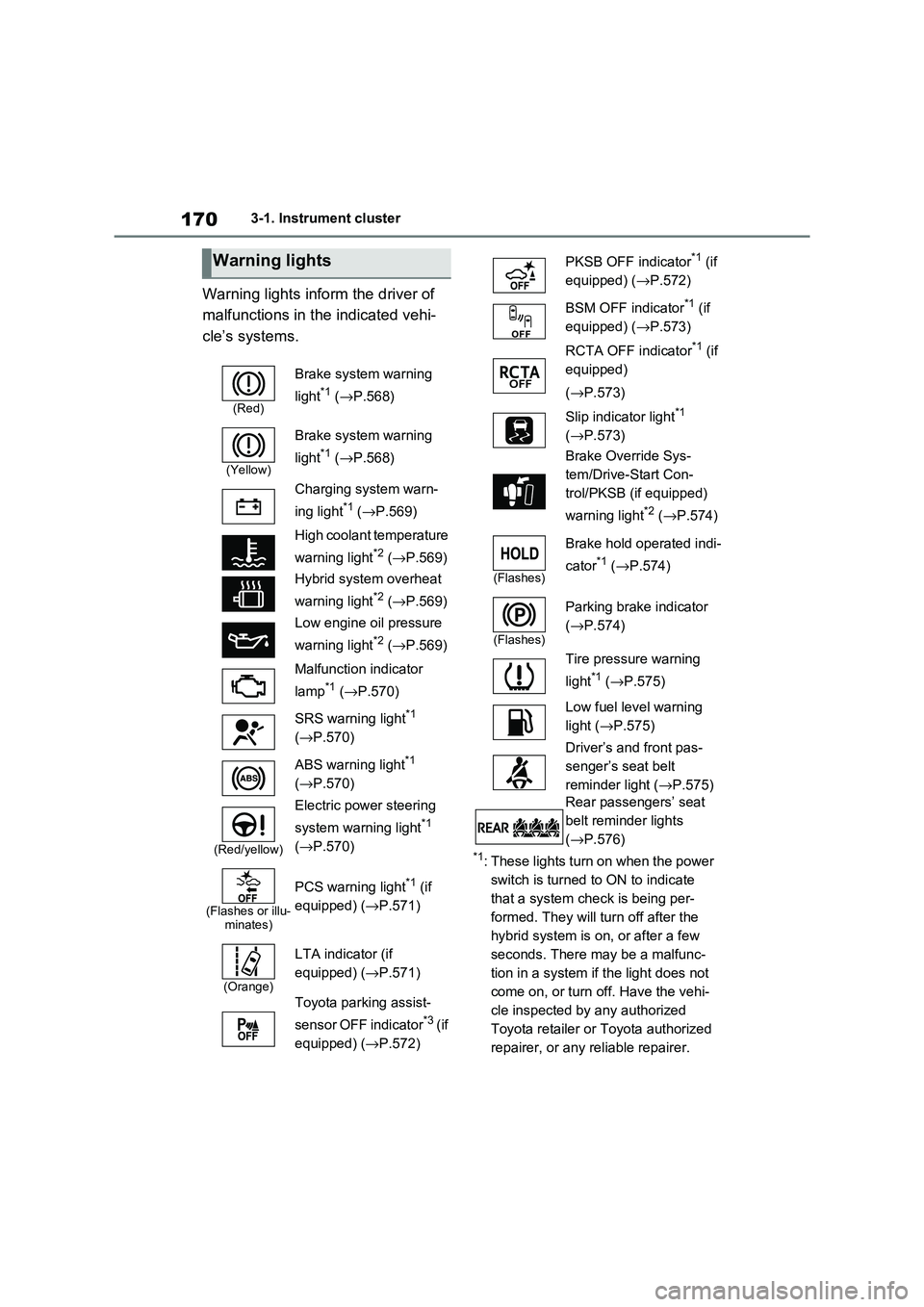
1703-1. Instrument cluster
Warning lights inform the driver of
malfunctions in the indicated vehi -
cle’s systems.
*1: These lights turn on when the power
switch is turned to ON to indicate
that a system check is being per -
formed. They will turn off after the
hybrid system is on , or after a few
seconds. There may be a malfunc-
tion in a system if the light does not
come on, or turn off. Have the vehi -
cle inspected by any authorized
Toyota retailer or Toyota authorized
repairer, or any reliable repairer.
Warning lights
(Red)
Brake system warning
light*1 ( →P.568)
(Yellow)
Brake system warning
light*1 ( →P.568)
Charging system warn -
ing light*1 ( →P.569)
High coolant temperature
warning light*2 ( →P.569)
Hybrid system overheat
warning light*2 ( →P.569)
Low engine oil pressure
warning light*2 ( →P.569)
Malfunction indicator
lamp*1 ( →P.570)
SRS warning light*1
( →P.570)
ABS warning light*1
( →P.570)
(Red/yellow)
Electric power steering
system warning light*1
( →P.570)
(Flashes or illu- minates)
PCS warning light*1 (if
equipped) ( →P.571)
(Orange)
LTA indicator (if
equipped) ( →P.571)
Toyota parking assist-
sensor OFF indicator*3 ( i f
equipped) ( →P.572)
PKSB OFF indicator*1 (if
equipped) ( →P.572)
BSM OFF indicator*1 (if
equipped) ( →P.573)
RCTA OFF indicator*1 (if
equipped)
( →P.573)
Slip indicator light*1
( →P.573)
Brake Override Sys -
tem/Drive-Start Con -
trol/PKSB (if equipped)
warning light*2 ( →P.574)
(Flashes)
Brake hold operated indi-
cator*1 ( →P.574)
(Flashes)
Parking brake indicator
( →P.574)
Tire pressure warning
light*1 ( →P.575)
Low fuel level warning
light ( →P.575)
Driver’s and front pas -
senger’s seat belt
reminder light ( →P.575)
Rear passengers’ seat
belt reminder lights
( →P.576)
Page 173 of 666
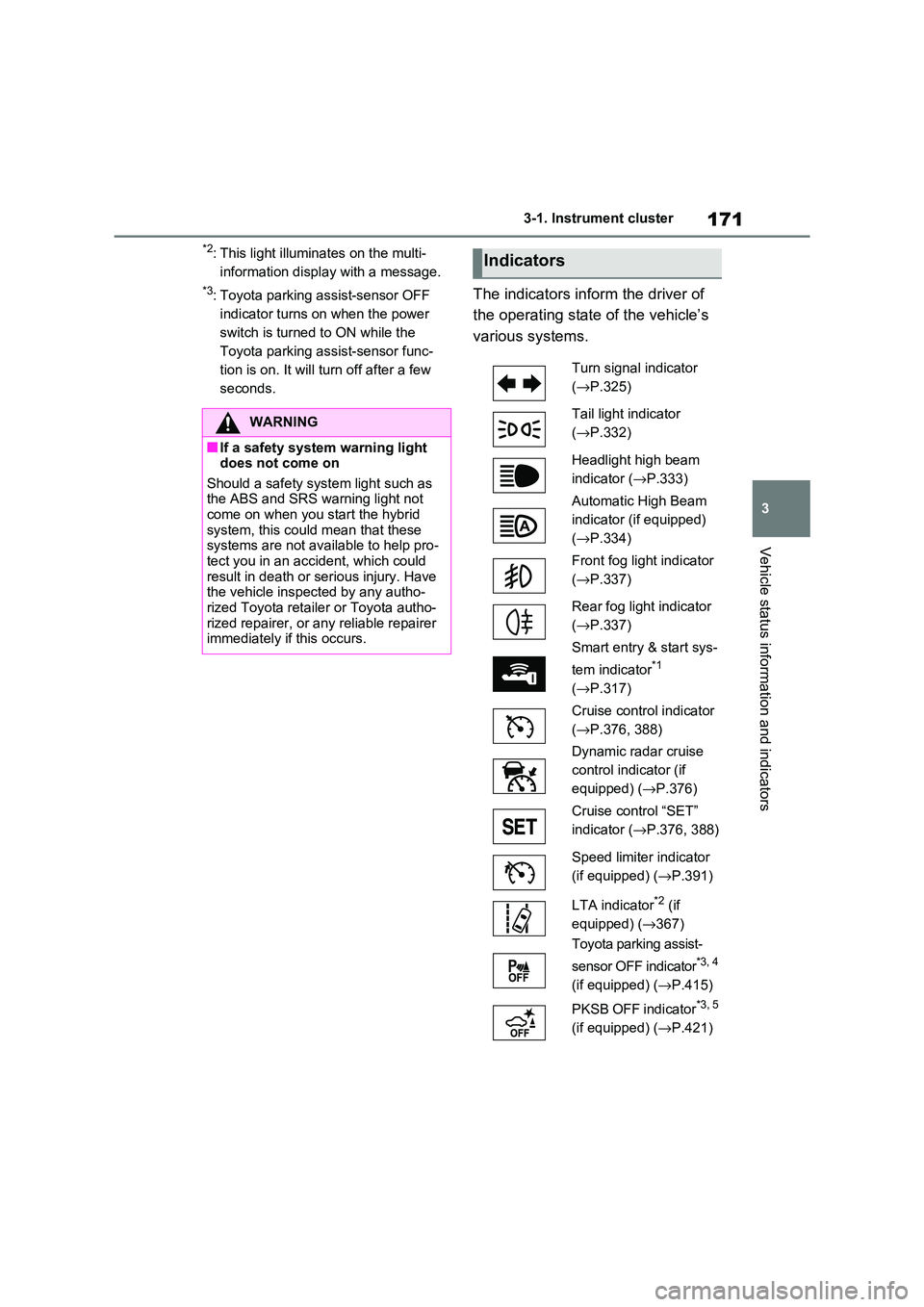
171
3
3-1. Instrument cluster
Vehicle status information and indicators
*2: This light illumina tes on the multi-
information displa y with a message.
*3: Toyota parking assist-sensor OFF
indicator turns on when the power
switch is turned to ON while the
Toyota parking a ssist-sensor func-
tion is on. It will turn off after a few
seconds.
The indicators inform the driver of
the operating state of the vehicle’s
various systems.
WARNING
■If a safety system warning light
does not come on
Should a safety syst em light such as the ABS and SRS wa rning light not
come on when you start the hybrid
system, this could mean that these systems are not ava ilable to help pro-
tect you in an accident, which could
result in death or serious injury. Have the vehicle inspected by any autho -
rized Toyota retailer or Toyota autho -
rized repairer, or any reliable repairer immediately if this occurs.
Indicators
Turn signal indicator
( →P.325)
Tail light indicator
( →P.332)
Headlight high beam
indicator ( →P.333)
Automatic High Beam
indicator (if equipped)
( →P.334)
Front fog light indicator
( →P.337)
Rear fog light indicator
( →P.337)
Smart entry & start sys -
tem indicator*1
( →P.317)
Cruise control indicator
( →P.376, 388)
Dynamic radar cruise
control indicator (if
equipped) ( →P.376)
Cruise control “SET”
indicator ( →P.376, 388)
Speed limiter indicator
(if equipped) ( →P.391)
LTA indicator*2 (if
equipped) ( →367)
Toyota parking assist-
sensor OFF indicator*3, 4
(if equipped) ( →P.415)
PKSB OFF indicator*3, 5
(if equipped) ( →P.421)
Page 371 of 666
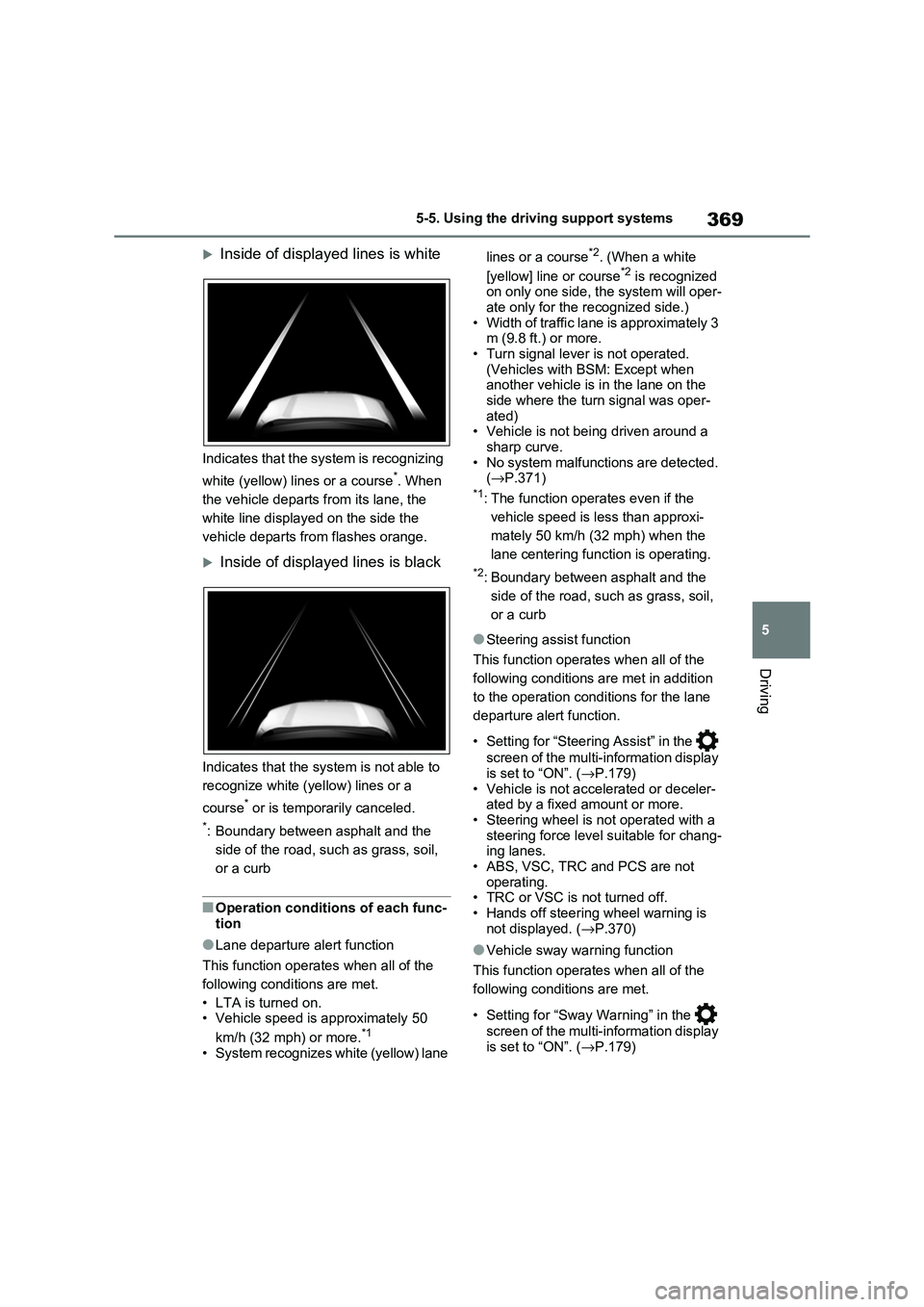
369
5
5-5. Using the driving support systems
Driving
Inside of displayed lines is white
Indicates that the system is recognizing
white (yellow) lines or a course*. When
the vehicle departs f rom its lane, the
white line display ed on the side the
vehicle departs from flashes orange.
Inside of displayed lines is black
Indicates that the syst em is not able to
recognize white (yellow) lines or a
course* or is temporarily canceled.
*: Boundary between asphalt and the
side of the road, su ch as grass, soil,
or a curb
■Operation conditions of each func -
tion
●Lane departure alert function
This function operates when all of the
following conditions are met.
• LTA is turned on. • Vehicle speed is approximately 50
km/h (32 mph) or more.*1
• System recognizes white (yellow) lane
lines or a course*2. (When a white
[yellow] line or course*2 is recognized on only one side, the system will oper -
ate only for the recognized side.)
• Width of traffic lane is approximately 3 m (9.8 ft.) or more.
• Turn signal lever is not operated.
(Vehicles with BSM: Except when another vehicle is in the lane on the
side where the turn signal was oper -
ated) • Vehicle is not bei ng driven around a
sharp curve.
• No system malfunctions are detected. ( →P.371)*1: The function operates even if the
vehicle speed is less than approxi -
mately 50 km/h (32 mph) when the
lane centering func tion is operating.
*2: Boundary between asphalt and the
side of the road, su ch as grass, soil,
or a curb
●Steering assist function
This function operates when all of the
following conditions are met in addition
to the operation condi tions for the lane
departure alert function.
• Setting for “Steering Assist” in the
screen of the multi-information display
is set to “ON”. ( →P.179)
• Vehicle is not accel erated or deceler- ated by a fixed amount or more.
• Steering wheel is not operated with a
steering force level suitable for chang - ing lanes.
• ABS, VSC, TRC and PCS are not
operating. • TRC or VSC is not turned off.
• Hands off steering wheel warning is
not displayed. ( →P.370)
●Vehicle sway warning function
This function operates when all of the
following conditions are met.
• Setting for “Sway Warning” in the
screen of the multi-information display is set to “ON”. ( →P.179)
Page 372 of 666
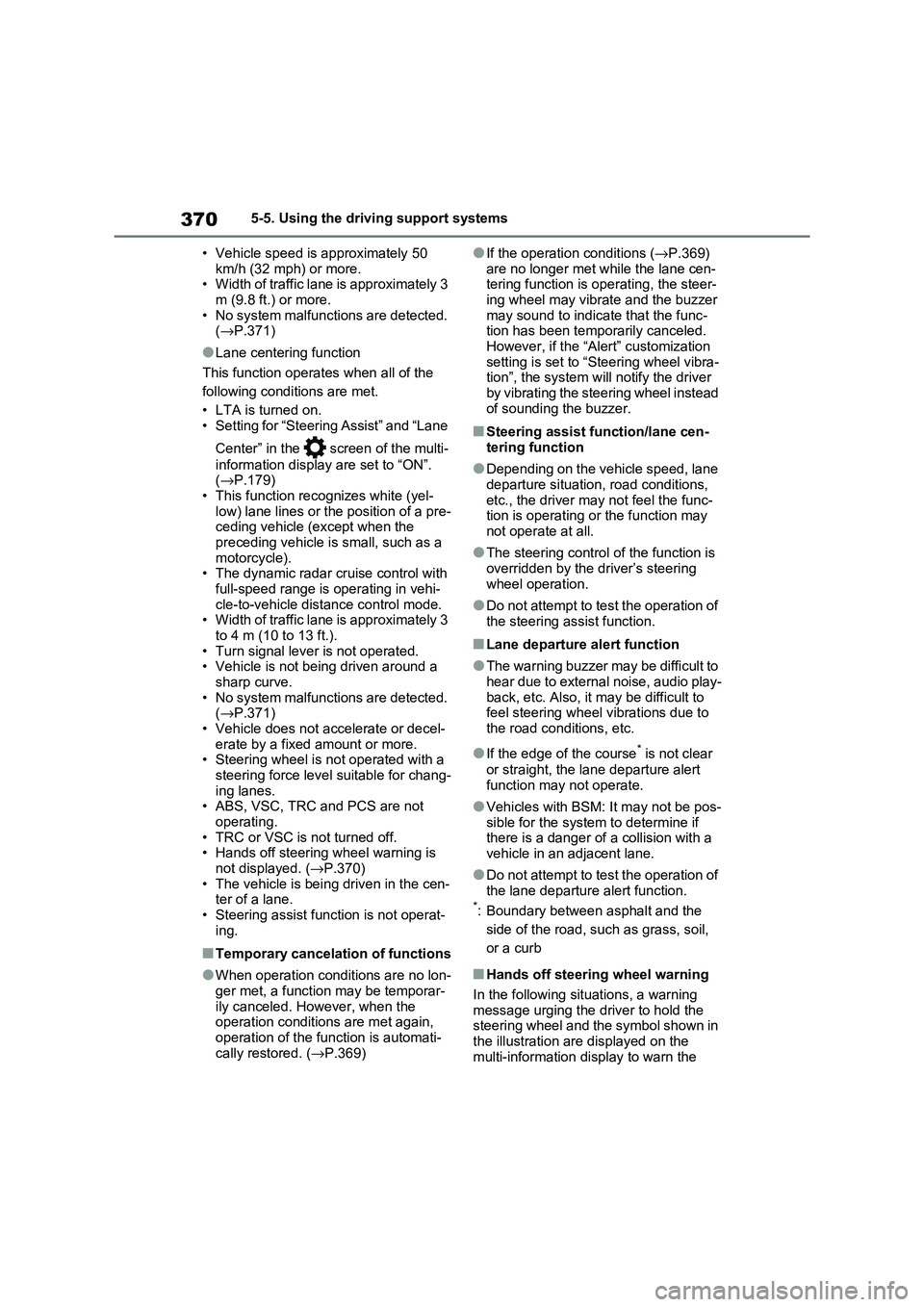
3705-5. Using the driving support systems
• Vehicle speed is approximately 50
km/h (32 mph) or more. • Width of traffic lane is approximately 3
m (9.8 ft.) or more.
• No system malfuncti ons are detected. ( →P.371)
●Lane centering function
This function operates when all of the
following conditions are met.
• LTA is turned on.
• Setting for “Steering Assist” and “Lane
Center” in the screen of the multi-
information display are set to “ON”. ( →P.179)
• This function recognizes white (yel -
low) lane lines or the position of a pre - ceding vehicle (except when the
preceding vehicle is small, such as a
motorcycle). • The dynamic radar cruise control with
full-speed range is operating in vehi-
cle-to-vehicle distance control mode. • Width of traffic lane is approximately 3
to 4 m (10 to 13 ft.).
• Turn signal lever is not operated. • Vehicle is not being driven around a
sharp curve.
• No system malfuncti ons are detected. ( →P.371)
• Vehicle does not accelerate or decel-
erate by a fixed amount or more. • Steering wheel is n ot operated with a
steering force level suitable for chang-
ing lanes. • ABS, VSC, TRC an d PCS are not
operating.
• TRC or VSC is not turned off. • Hands off steering wheel warning is
not displayed. ( →P.370)
• The vehicle is being driven in the cen- ter of a lane.
• Steering assist func tion is not operat-
ing.
■Temporary cancelation of functions
●When operation conditions are no lon -
ger met, a function may be temporar - ily canceled. However, when the
operation conditions are met again,
operation of the fu nction is automati- cally restored. ( →P.369)
●If the operation conditions (→P.369)
are no longer met while the lane cen- tering function is op erating, the steer-
ing wheel may vibrate and the buzzer
may sound to indicate that the func - tion has been temporarily canceled.
However, if the “Aler t” customization
setting is set to “Steering wheel vibra - tion”, the system will notify the driver
by vibrating the steering wheel instead
of sounding the buzzer.
■Steering assist function/lane cen - tering function
●Depending on the vehicle speed, lane departure situation, road conditions,
etc., the driver may not feel the func -
tion is operating or the function may not operate at all.
●The steering control of the function is overridden by the dr iver’s steering
wheel operation.
●Do not attempt to test the operation of
the steering assist function.
■Lane departure alert function
●The warning buzzer may be difficult to
hear due to external noise, audio play -
back, etc. Also, it may be difficult to feel steering wheel vibrations due to
the road conditions, etc.
●If the edge of the course* is not clear
or straight, the lane departure alert
function may not operate.
●Vehicles with BSM: It may not be pos-
sible for the syste m to determine if there is a danger of a collision with a
vehicle in an adjacent lane.
●Do not attempt to test the operation of
the lane departure alert function.*: Boundary between a sphalt and the
side of the road, such as grass, soil,
or a curb
■Hands off steering wheel warning
In the following situations, a warning message urging the driver to hold the
steering wheel and the symbol shown in
the illustration are displayed on the multi-information display to warn the
Page 380 of 666
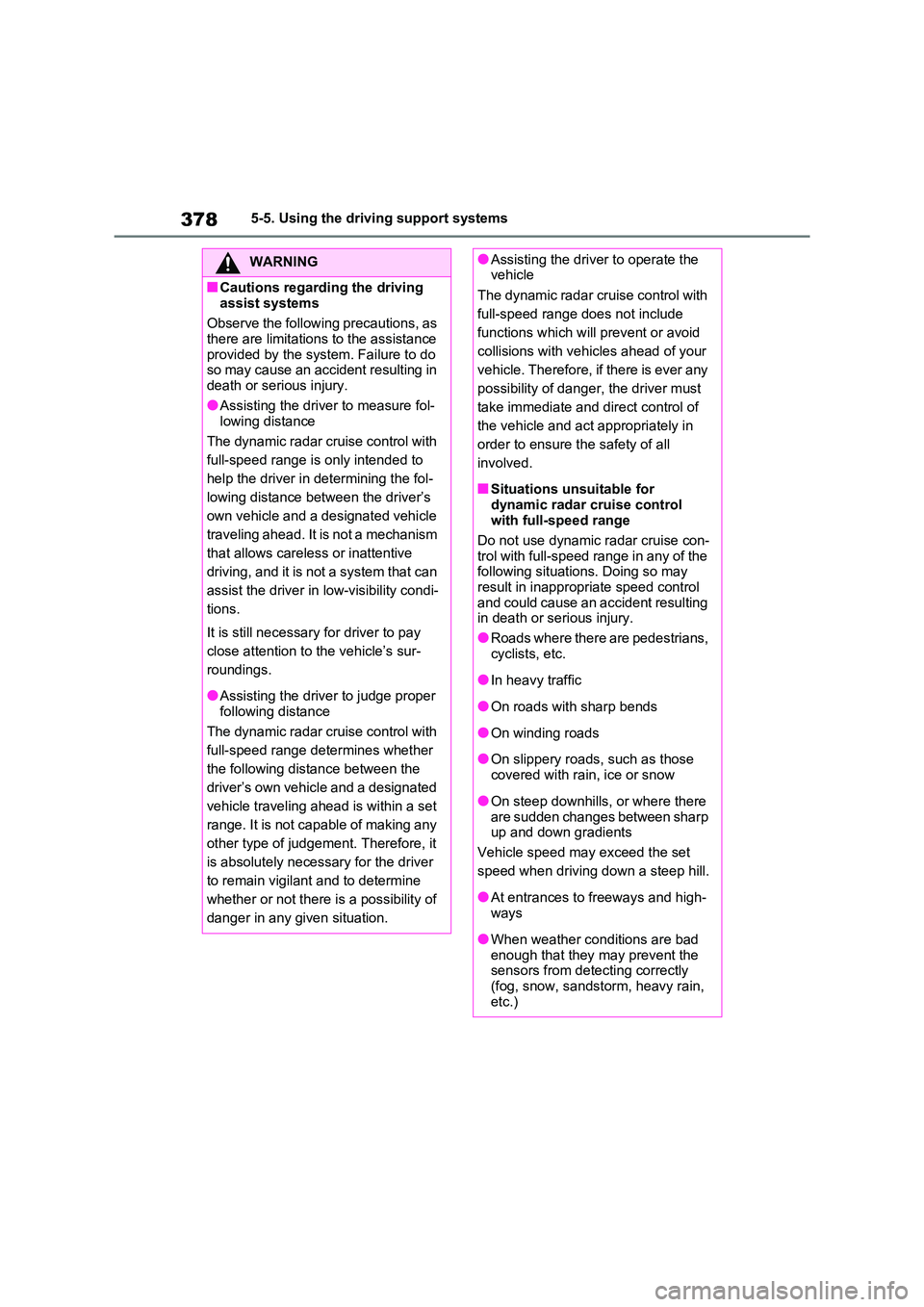
3785-5. Using the driving support systems
WARNING
■Cautions regarding the driving
assist systems
Observe the following precautions, as there are limitations to the assistance
provided by the syst em. Failure to do
so may cause an accident resulting in death or serious injury.
●Assisting the driver to measure fol -
lowing distance
The dynamic radar cruise control with
full-speed range is only intended to
help the driver in determining the fol -
lowing distance bet ween the driver’s
own vehicle and a designated vehicle
traveling ahead. It is not a mechanism
that allows carele ss or inattentive
driving, and it is not a system that can
assist the driver in low-visibility condi-
tions.
It is still necessary for driver to pay
close attention to the vehicle’s sur -
roundings.
●Assisting the driver to judge proper
following distance
The dynamic radar cruise control with
full-speed range determines whether
the following dist ance between the
driver’s own vehicle and a designated
vehicle traveling ahead is within a set
range. It is not capable of making any
other type of judgemen t. Therefore, it
is absolutely necessary for the driver
to remain vigilant and to determine
whether or not there is a possibility of
danger in any given situation.
●Assisting the driver to operate the vehicle
The dynamic radar cruise control with
full-speed range does not include
functions which will prevent or avoid
collisions with vehi cles ahead of your
vehicle. Therefore, if there is ever any
possibility of danger, the driver must
take immediate and direct control of
the vehicle and act appropriately in
order to ensure the safety of all
involved.
■Situations unsuitable for
dynamic radar cruise control
with full-speed range
Do not use dynamic radar cruise con-
trol with full-speed range in any of the
following situations. Doing so may result in inappropriate speed control
and could cause an accident resulting
in death or serious injury.
●Roads where there are pedestrians,
cyclists, etc.
●In heavy traffic
●On roads with sharp bends
●On winding roads
●On slippery roads, such as those
covered with rain, ice or snow
●On steep downhills, or where there
are sudden changes between sharp
up and down gradients
Vehicle speed may exceed the set
speed when driving down a steep hill.
●At entrances to freeways and high - ways
●When weather conditions are bad
enough that they may prevent the sensors from detecting correctly
(fog, snow, sandstorm, heavy rain,
etc.)
Page 419 of 666
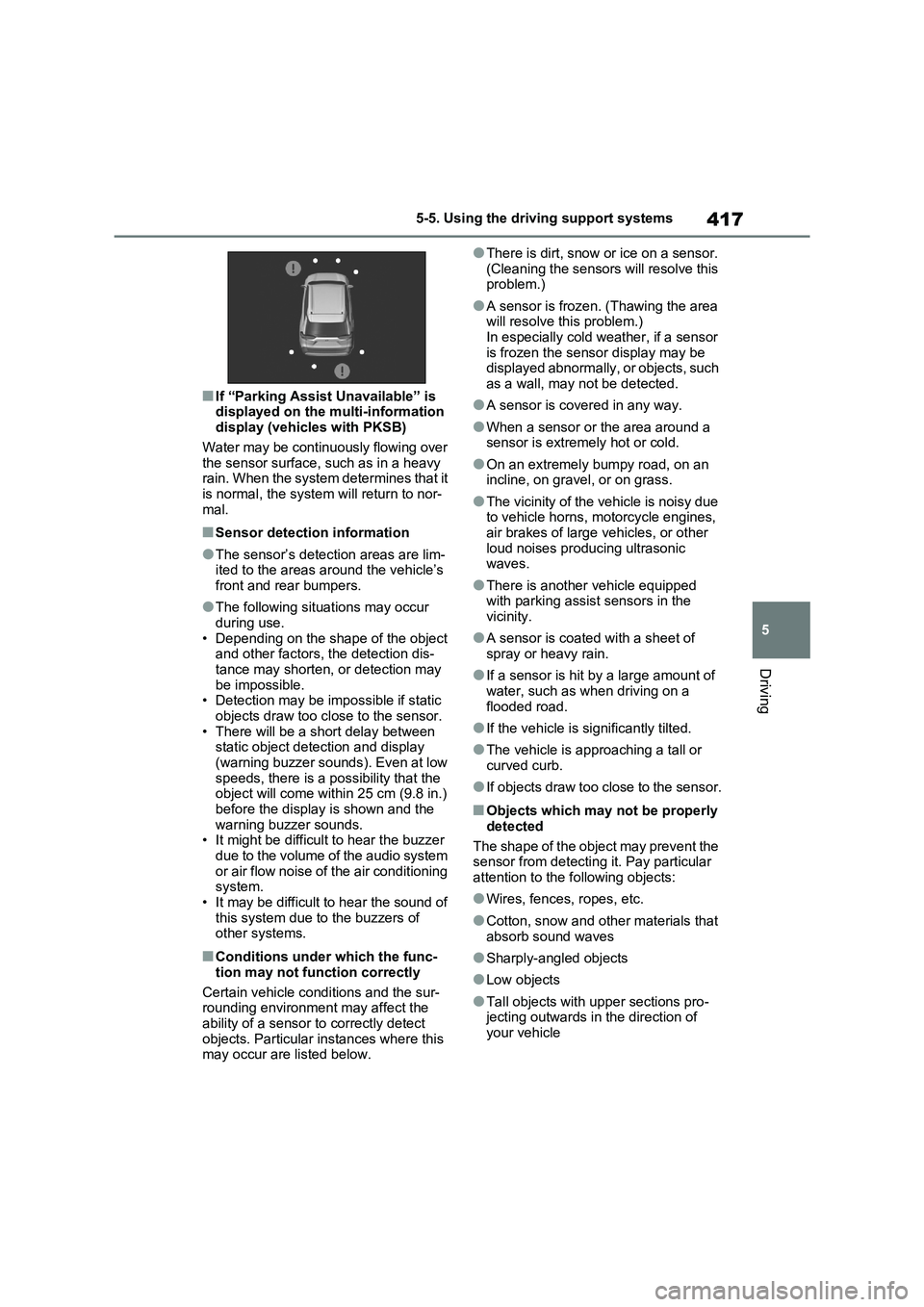
417
5
5-5. Using the driving support systems
Driving
■If “Parking Assist Unavailable” is
displayed on the multi-information display (vehicles with PKSB)
Water may be continuously flowing over
the sensor surface, such as in a heavy rain. When the system determines that it
is normal, the system will return to nor-
mal.
■Sensor detection information
●The sensor’s detec tion areas are lim-
ited to the areas aro und the vehicle’s front and rear bumpers.
●The following situations may occur during use.
• Depending on the shape of the object
and other factors, t he detection dis- tance may shorten, or detection may
be impossible.
• Detection may be impossible if static objects draw too close to the sensor.
• There will be a shor t delay between
static object detec tion and display (warning buzzer sounds). Even at low
speeds, there is a possibility that the
object will come withi n 25 cm (9.8 in.) before the display is shown and the
warning buzzer sounds.
• It might be difficu lt to hear the buzzer due to the volume of the audio system
or air flow noise of the air conditioning
system. • It may be difficult to hear the sound of
this system due t o the buzzers of
other systems.
■Conditions under which the func -
tion may no t function correctly
Certain vehicle c onditions and the sur-
rounding environment may affect the
ability of a sensor to correctly detect objects. Particular instances where this
may occur are listed below.
●There is dirt, snow or ice on a sensor.
(Cleaning the sensors will resolve this problem.)
●A sensor is frozen. (Thawing the area will resolve this problem.)
In especially cold weather, if a sensor
is frozen the sensor display may be displayed abnormally, or objects, such
as a wall, may not be detected.
●A sensor is covered in any way.
●When a sensor or the area around a sensor is extremely hot or cold.
●On an extremely bumpy road, on an incline, on grav el, or on grass.
●The vicinity of the vehicle is noisy due to vehicle horns, motorcycle engines,
air brakes of large vehicles, or other
loud noises pro ducing ultrasonic waves.
●There is another vehicle equipped with parking assist sensors in the
vicinity.
●A sensor is coated with a sheet of
spray or heavy rain.
●If a sensor is hit by a large amount of
water, such as when driving on a
flooded road.
●If the vehicle is significantly tilted.
●The vehicle is approaching a tall or
curved curb.
●If objects draw too close to the sensor.
■Objects which may not be properly
detected
The shape of the object may prevent the sensor from detecting it. Pay particular
attention to the following objects:
●Wires, fences, ropes, etc.
●Cotton, snow and other materials that
absorb sound waves
●Sharply-angled objects
●Low objects
●Tall objects with upper sections pro- jecting outwards in the direction of
your vehicle
Page 440 of 666
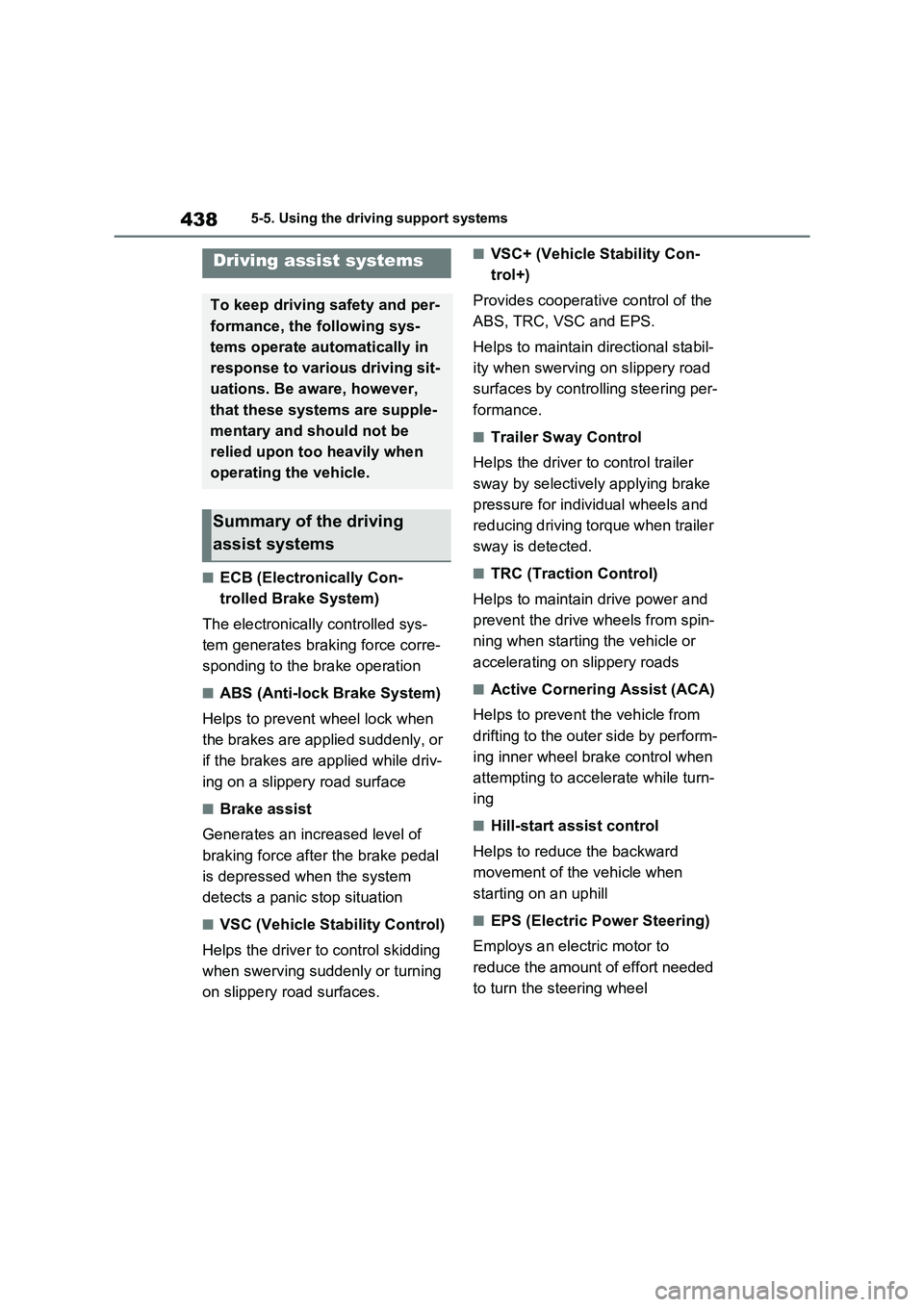
4385-5. Using the driving support systems
■ECB (Electronically Con-
trolled Brake System)
The electronically controlled sys -
tem generates braking force corre -
sponding to the brake operation
■ABS (Anti-lock Brake System)
Helps to prevent wheel lock when
the brakes are applied suddenly, or
if the brakes are applied while driv -
ing on a slippery road surface
■Brake assist
Generates an increased level of
braking force after the brake pedal
is depressed when the system
detects a panic stop situation
■VSC (Vehicle Stability Control)
Helps the driver to control skidding
when swerving suddenly or turning
on slippery road surfaces.
■VSC+ (Vehicle Stability Con -
trol+)
Provides cooperative control of the
ABS, TRC, VSC and EPS.
Helps to maintain directional stabil -
ity when swerving on slippery road
surfaces by controlling steering per -
formance.
■Trailer Sway Control
Helps the driver t o control trailer
sway by selectively applying brake
pressure for individual wheels and
reducing driving torque when trailer
sway is detected.
■TRC (Traction Control)
Helps to maintain drive power and
prevent the drive wheels from spin -
ning when starting the vehicle or
accelerating on slippery roads
■Active Cornering Assist (ACA)
Helps to prevent t he vehicle from
drifting to the outer side by perform -
ing inner wheel brake control when
attempting to acc elerate while turn-
ing
■Hill-start assist control
Helps to reduce the backward
movement of the vehicle when
starting on an uphill
■EPS (Electric Po wer Steering)
Employs an electric motor to
reduce the amount of effort needed
to turn the steering wheel
Driving assist systems
To keep driving safety and per -
formance, the following sys -
tems operate aut omatically in
response to various driving sit -
uations. Be aware, however,
that these sys tems are supple-
mentary and should not be
relied upon too heavily when
operating the vehicle.
Summary of the driving
assist systems
Page 441 of 666
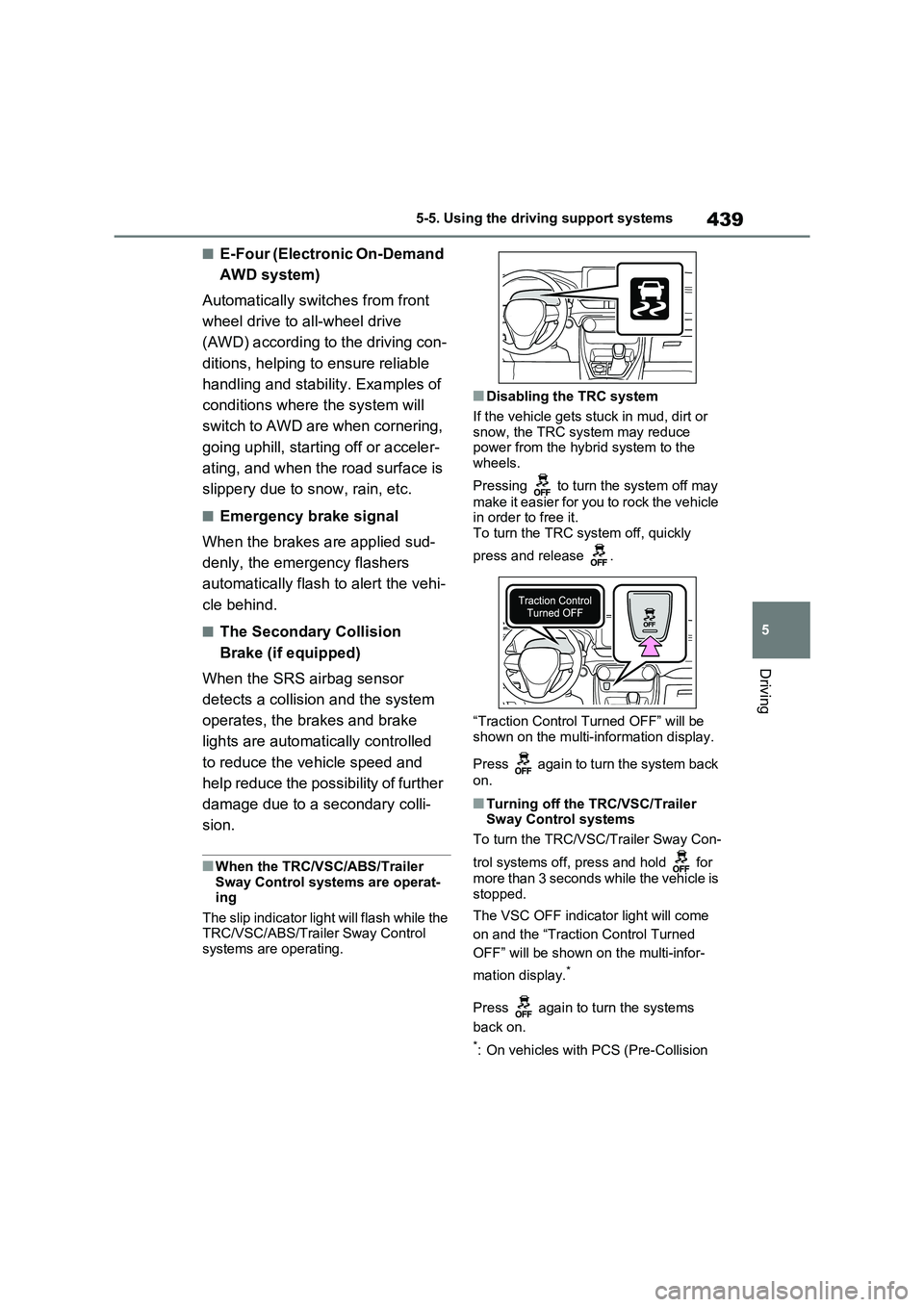
439
5
5-5. Using the driving support systems
Driving
■E-Four (Electronic On-Demand
AWD system)
Automatically switches from front
wheel drive to all-wheel drive
(AWD) according to the driving con -
ditions, helping to ensure reliable
handling and stability. Examples of
conditions where the system will
switch to AWD are when cornering,
going uphill, start ing off or acceler-
ating, and when the road surface is
slippery due to snow, rain, etc.
■Emergency brake signal
When the brakes are applied sud -
denly, the emergency flashers
automatically flash to alert the vehi -
cle behind.
■The Secondary Collision
Brake (if equipped)
When the SRS airbag sensor
detects a collision and the system
operates, the brakes and brake
lights are automatically controlled
to reduce the v ehicle speed and
help reduce the possibility of further
damage due to a secondary colli -
sion.
■When the TRC/VSC/ABS/Trailer Sway Control syst ems are operat-
ing
The slip indicator light will flash while the TRC/VSC/ABS/Traile r Sway Control
systems are operating.
■Disabling the TRC system
If the vehicle gets stuck in mud, dirt or snow, the TRC system may reduce
power from the hyb rid system to the
wheels.
Pressing to turn t he system off may
make it easier for you to rock the vehicle
in order to free it.
To turn the TRC system off, quickly
press and release .
“Traction Control Tu rned OFF” will be
shown on the multi-information display.
Press again to turn the system back
on.
■Turning off the TRC/VSC/Trailer
Sway Control systems
To turn the TRC/VS C/Trailer Sway Con-
trol systems off, press and hold for
more than 3 seconds wh ile the vehicle is
stopped.
The VSC OFF indicator light will come
on and the “Tractio n Control Turned
OFF” will be shown on the multi-infor-
mation display.*
Press again to turn the systems
back on.
*: On vehicles with PCS (Pre-Collision